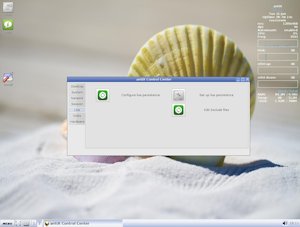What is Persistence?

Persistence is a hybrid between a LiveCD/USB and a full install. One of the beauties of a LiveCD is that it allows you to boot Linux without touching any hard drives so you can have a "test-drive" without fear of altering your current system. Another feature of a LiveCD is that once it is burned, it is close to impossible for it to get infected with a virus or a Trojan horse. Every time you boot it, you start off with a system that is clean and pristine.
Persistence gives you a way of remembering things between boots. In order to do so, it needs access to a read-write device, typically either a hard drive or a USB stick. If you are only using one machine that is yours then you can put the persistence file(s)s on one of your hard drives.
Four Kinds of Persistence
The antiX distribution offers up to four different forms of persistence on our Live Media (LiveCD/DVD/USB, etc). Remastering is only available on writable media such as a LiveUSB or a LiveHD (frugal install) not a CD or DVD. All four forms can be used together if desired. They each have different strengths and weakness which are important to understand in order choose the right method or methods for your purposes.
Home Persistence
Home persistence is the simplest and safest. The homefs persistence file
is mounted at /home. Any changes made to files under /home are (nearly)
instantly stored on homefs filesystem. It is good if you want to save
settings (such as bookmarks or changes to your desktop) but it doesn’t save
changes made to the system (such as installing packages). Generally, if you
need the root password to do it then it is not saved. Home persistence is
also ideal if you want to download and save a lot of data. It is the safest
precisely because you can’t save any system changes with it. Even if your
system gets compromised, it will be very difficult for the bad guys to make
any permanent changes to your system.
Root Persistence
Root persistence allows you to save changes to the system in addition to
saving personal settings. It has two significant limitations. These
limitations are due to the fact that as the system is running the changes are
stored in RAM and will be lost unless they are specifically copied back to the
rootfs file. If your computer crashes before the changes are copied back
then your changes will be lost. The other limitation is that the amount of
new information you can store is limited by how much free RAM you have.
Dynamic root persistence saves file system changes in RAM (just like a normal LiveCD/USB). The persist-save program must be run to copy these changes to the rootfs file so they can be remembered across reboots. Use persist-config to have the program run automatically on shutdown/reboot.
Static Root Persistence
Static root persistence is another way to use persistence. Static root persistence saves file system changes directly in the rootfs file. It does not use any RAM so the only size limit is the size of the rootfs file. This makes it good for doing an "apt-get upgrade" or for installing a bunch of packages. It is usually best to follow up with a Live remaster to consolidate the file system changes into the compressed squashfs file. On many systems, static root persistence can be annoyingly slow. You are free to switch between static and dynamic root persistence each time you boot.
Frugal Installation
If you have access to a hard drive, you may wish to run antiX from it live with or without persistence. Using persistence is recommended. The main advantage of running frugally is that it is very fast and saves space since it uses the compressed squashfs (linuxfs) which is typically 4 times smaller than installed to hard drive. antiX has made setting up frugal very easy. Just press F5 at the boot menu and choose the frugal option. See How do I Create Persistence Files? below for further details.
Remastering
We include remastering as a form of persistence for purposes of comparison. The Remastering page contains implementation details. If root persistence is like using a piton while climbing up a cliff, remastering is more like setting up a camp or bivouac site.
How does it Work?
The information for both root and home persistence is stored in two files
called rootfs and homefs. Unlike previous versions of antiX, there is no longer
an option to use a entire partition for root or home persistence. The default
location for these files is right next to the squashfs file, on the same
device and in the same directory. We suggest that you use this default
location whenever possible, but sometimes it is not possible (such as when
booting from a LiveCD or LiveDVD). For these cases you can specify which
device the persistence files are on. You can also specify a different
directory.
How do I Create Persistence Files?
Automatically
The homefs and rootfs persistence files can be created when booting at
the live desktop menu. Press F5, choose the persist option and on boot you
will be prompted to set it up. You will be first asked where you want to save
the persistent file(s). You just need to decide how large you want
to make the file(s). The ext4 file system will be used.
Once the homefs and rootfs files have been created, you will be prompted to
make changes to the root and user passwords. This is for security.
The final step will ask you how you want to set the save mode for root
persistence. Options include: Automatic, Semi_Automatic and Manual Save.
On reboot/halt any changes will be saved.
Note: If you have your persistence file(s) on a separate device to the one you boot from, you must specify your persistence device. You can use the following: * pdev=sda1 ie persist device * plab=antiX-Persist ie label of the device where persistence files are kept * puuid=xxxxxxx ie the uuid of the device.
Video
antiX 17 - Make a live-USB with persistence! https://www.youtube.com/watch?v=qq0mRZh2hiY&t=2s
Remaster your antiX live-USB https://www.youtube.com/watch?v=LpI_a4xPKdM&t=2s
by runwiththedolphin
